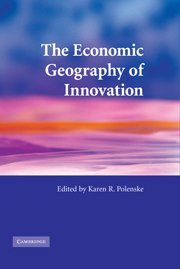Book contents
- Frontmatter
- Contents
- List of figures
- List of tables
- Notes on contributors
- Acknowledgments
- Abstracts
- List of abbreviations and acronyms
- Part I Concepts and measurements in innovation
- 1 Introduction
- 2 Measurement of the clustering and dispersion of innovation
- 3 Measuring the geography of innovation: a literature review
- 4 Employment growth and clusters dynamics of creative industries in Great Britain
- Part II Institutional and spatial aspects of information and knowledge flows
- Part III Institutions and innovation systems
- Index
- References
3 - Measuring the geography of innovation: a literature review
Published online by Cambridge University Press: 22 September 2009
- Frontmatter
- Contents
- List of figures
- List of tables
- Notes on contributors
- Acknowledgments
- Abstracts
- List of abbreviations and acronyms
- Part I Concepts and measurements in innovation
- 1 Introduction
- 2 Measurement of the clustering and dispersion of innovation
- 3 Measuring the geography of innovation: a literature review
- 4 Employment growth and clusters dynamics of creative industries in Great Britain
- Part II Institutional and spatial aspects of information and knowledge flows
- Part III Institutions and innovation systems
- Index
- References
Summary
Introduction
Innovation has a spatial distribution. Many researchers, including those we review in this chapter, have recently studied the spatial distribution and concentration of innovation, or “innovation geography” for short, and the underlying mechanisms by which innovation occurs and spreads/concentrates. Any empirical study of innovation geography requires measurement. However, as Carter discusses (2006, chapter 2 this volume), measuring innovation and its geography is difficult both conceptually and empirically. Indeed, measurement continues to be one of the most challenging issues in the studies of innovation geography. As Zvi Griliches (1994) pointed out, many unresolved empirical issues in economics are just measurement problems. The same is true for studies of innovation geography. Although limited data availability is a major obstacle to studying innovation geography, inadequate theoretical models and conceptual precision also weaken the ability of analysts to determine appropriate data and to devise robust empirical indicators, indices, tests, and analyses of innovation. In other words, precise measurement of innovation geography requires precise concepts and definitions.
Nevertheless, innovation-geography analysts have found data and attempted ingenious ways to measure innovation and its distributive patterns, mainly using indicators and indices, often by adopting and adjusting various available indicators of regional growth. First, we discuss the different data they use to measure different aspects of innovation, in general, to illustrate that innovation is still a broad and poorly defined concept. Of the several extensive reviews of measurement issues in science, technology, and innovation (STI) studies, we have found some to be especially relevant.
- Type
- Chapter
- Information
- The Economic Geography of Innovation , pp. 30 - 59Publisher: Cambridge University PressPrint publication year: 2007
References
- 17
- Cited by



